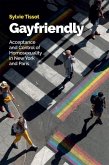What does it mean to be gayfriendly? Having gay friends, supporting gay marriage, remaining unfazed when one's son or daughter comes out? Going to gay bars or questioning one's own sexual orientation? There is no single model of 'gayfriendliness', but rather different attitudes which vary according to age, sex, country and life circumstance. Acceptance of homosexuality has undeniably grown, and homosexuality is increasingly seen as one form of sexuality among others. But embedded in this liberal vision is a perspective that is more troubling. Based on interviews with gayfriendly straight people in the liberal neighbourhoods of Park Slope in New York and the Marais in Paris, Sylvie Tissot shows that stereotypes remain and control of gays and lesbians has not disappeared. Acceptance is directed towards those who are of the same socioeconomic background, who proclaim their wish to emulate traditional norms of family life, and who do not make any other demands. Gays must be normal but not completely so, similar and at the same time different, in order to meet the not always conscious conditions of acceptability. Gayfriendliness has managed to dispel violence and discrimination and has accompanied the invention of less conventional lives. But, as Tissot shows, it has not yet liberated itself from the clutches of heterosexual domination which still structures our society and our ways of thinking.
Dieser Download kann aus rechtlichen Gründen nur mit Rechnungsadresse in D ausgeliefert werden.
"As anti-gay and anti-trans sentiment surges, the illusion of a rainbow coloured world of queer inclusion is rendered ever more apparent and the need for critical and complex analysis becomes ever more pressing. Sylvie Tissot has given us just such an analysis. In this compelling comparative study of two 'gayfriendly' oases, she unpacks the often contradictory affects of both queers and straights as they imagine sexual identities in supposedly 'tolerant' urban spaces and, in so doing, offers a critical commentary on the limits of tolerance and the possibilities of radical inclusion in a world still governed by normative heterosexuality. A smart and nuanced addition to the burgeoning literature on queer spaces and the promises (and limits) of straight allyship."
Suzanna Danuta Walters, author of The Tolerance Trap: How God, Genes, and Good Intentions Sabotaged Gay Equality
Suzanna Danuta Walters, author of The Tolerance Trap: How God, Genes, and Good Intentions Sabotaged Gay Equality









